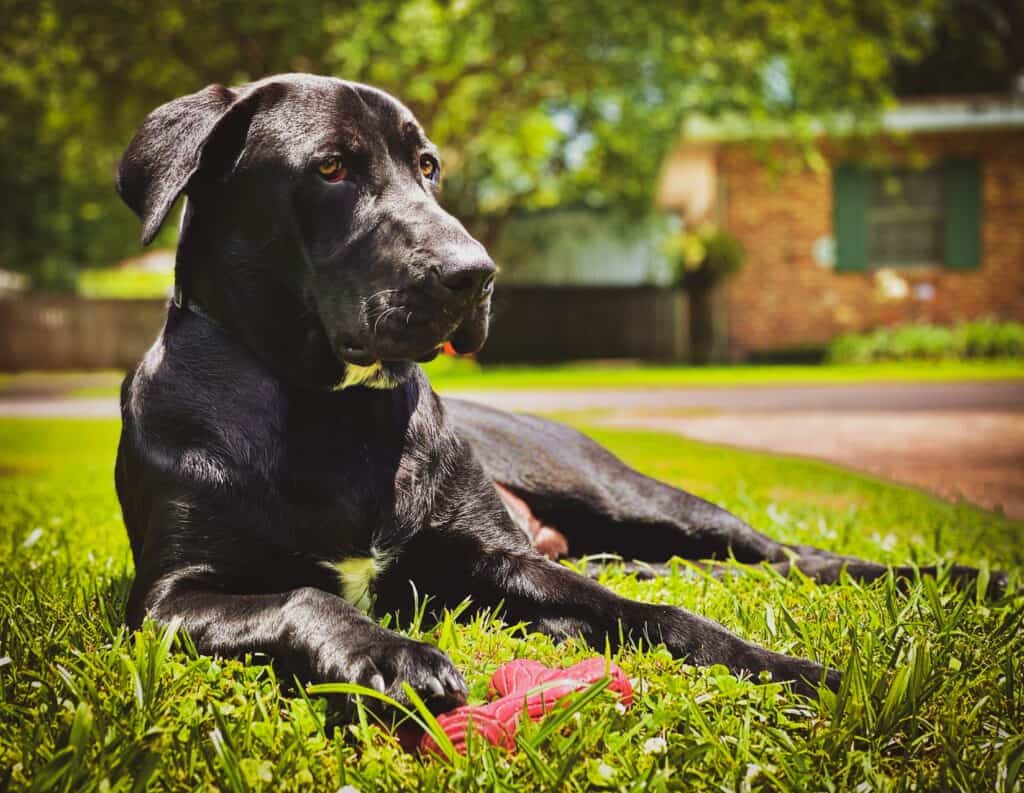Labrabull
Canis lupus
Labrabulls are incredibly clever, and training them is easy because they love to please and don't have a stubborn bone in their body.
Advertisement
Labrabull Scientific Classification
- Kingdom
- Animalia
- Phylum
- Chordata
- Class
- Mammalia
- Order
- Carnivora
- Family
- Canidae
- Genus
- Canis
- Scientific Name
- Canis lupus
Read our Complete Guide to Classification of Animals.
Labrabull Conservation Status
Labrabull Facts
- Name Of Young
- Puppy
- Group Behavior
- Solitary
- Fun Fact
- Labrabulls are incredibly clever, and training them is easy because they love to please and don't have a stubborn bone in their body.
- Gestation Period
- 58 to 68 days
- Litter Size
- 5 to 10 puppies
Labrabull Physical Characteristics
- Color
- Brown
- Grey
- Yellow
- Black
- White
- Silver
- Skin Type
- Fur
- Height
- 20 to 24 inches
- Age of Sexual Maturity
- 6 to 9 months
- Age of Weaning
- 3 to 6 weeks
- Aggression
- High
Labrabull as a Pet:
- General Health
- Energy Level
- Shedability
- Trainability
- Intelligence
- Tendency to Chew
- Size
- Family and kid friendliness
- Yappiness / Barking
- High
- Separation Anxiety
- Moderate
- Preferred Temperature
- Warm climate
- Exercise Needs
- High
- Friendly With Other Dogs
- Moderate
- Pure bred cost to own
- $500 to $1,000
- Dog group
- Non-sporting
- Male weight
- 45-95 lbs
- Female weight
- 5-94 lbs
View all of the Labrabull images!
The Labrabull is a cross between a Labrador Retriever and Pittbull Terrier. They were crossbred to create a breed that portrays the best traits of both parents and weed out any negative characteristics. These hybrids are perfect for dog lovers who are looking for a friendly yet protective companion.
However, Labrabulls are not for everyone because they are a relatively new breed, and there’s no way of knowing which parent they will take after. As a result, they can inherit traits entirely from one parent as opposed to both.
Four Different Types of Labrador Retriever and American Pitbull Terrier Mixes
There are several Labrador and Pittbull mixes, including:
Boxador
The Boxador is a mix of Labrador and Boxer, resulting in a loyal and active breed. Dog lovers are drawn to their friendly, social, and fun-loving personalities. However, they can be boisterous and are not a suitable breed for inactive households.
In addition, puppies require early training and socialization to curb their hyperactive and overprotective behavior.
Labradane
Labradanes are a gorgeous mix of Labrador and Great Dane. Obviously, this is a large breed, but what makes them special is their gentle nature. The Labradane can get very attached to their owners and enjoy sharing a home with big families who can give them a lot of attention.
This breed often forgets how big they are, so even though they are playful and friendly, Laradanes might not be suitable for families with young children, as they could accidentally knock them over when excited.
Pitsky
The Pitsky is a cross between a Siberian Husky and a Pitbull. These dogs are perfect for husky lovers who live in warm climates but don’t want to expose the purebred to sweltering temperatures with their thick coats.
This breed is intelligent and spirited but can be demanding and dominant. Pitskies will fit in well with active families due to their high energy levels.
Bull Pitbull
Bull Pitbulls are a cross between a Bull Mastiff and Pittbull and are the least popular Pitbull mix. But, despite their large size and parent breeds’ notoriety, they are gentle and love dogs. They love spending time with their family and enjoy outdoor activities.
However, they are very protective of their loved ones and can be aggressive towards strangers if not socialized from a young age.
Three Pros and Cons of Owning a Labrabull
Before buying a Labrabull, it’s important to know the pros and cons of owning this breed:
Pros
- Labrabulls are highly intelligent
- They are easy to train
- These dogs require minimal grooming
Cons
- They are not suited to apartment living
- Labrabulls shed a lot
- They are known for nipping, play-biting, and chewing and may try to you herd you and your family
The Best Dog Food for a Labrabull
The Labrabull is very energetic, so they need food to fuel their active bodies. Therefore, high-calorie dog food is ideal for this breed.
While they are very active, Labrabulls are prone to obesity, so owners should never overfeed them. By dividing their food into small meals given throughout the day, dog lovers can ensure that their pup is not overindulging.
In addition, their rough play can put a lot of strain on their joints, so adding a glucosamine supplement to their diet will be beneficial.
Labrabull Size and Weight
Labrabulls differ in size depending on which parent they take after, but can typically weigh around 45 to 95 pounds and measure 20 to 24 inches tall.
Labrabull Common Health Issues
In general, the Labrabull is a healthy breed. However, they are susceptible to health issues inherited from their parents, which may include:
- Allergies
- Obesity
- Skin and ear infections
- Hip and elbow dysplasia
- Bloat
- Hypothyroidism
- Epilepsy
- OCD disorder
The Labrabull can live a long and healthy life of between 10 to 15 years.
Labrabull Temperament
Most people will associate the Labrabull with the aggressive reputation of the Pitbull. However, they are excellent family pets if cared for in a loving home and socialized and trained from an early age.
This breed is incredibly clever, and training them is easy because they love to please and don’t have a stubborn bone in their body.
How to Take Care of a Labrabull

Labrabulls are not for everyone because they are a relatively new breed, and there’s no way of knowing which parent they will take after.
©Literallyclover/Shutterstock.com
Taking care of a Labrabull is easier than one might think. They are incredibly low maintenance and a blessing to any home.
Grooming
The Labrabull has short, coarse hair inherited from both parents, so grooming is straightforward and quick. However, they shed a lot and must be brushed twice a week to keep the shedding at bay.
Owners should only bathe them if they are extremely dirty, as they have natural oils that keep their skin healthy and moisturized.
In addition, owners must regularly check their ears for inflammation or infections. Their nails grow quite quickly and need trimming once every 3 months. Dental health is essential, and you should brush their teeth daily with a toothpaste specially formulated for dogs.
Training
Because Labrabulls are so intelligent and live to please, training is easy. However, they do have a fighting and aggressive nature, which can be curbed if trained properly and from a young age.
Due to their dominant nature, they are not the best breed for first-time dog owners unless enrolled in obedience classes or group training.
While they are muscular and intimidating dogs, they are incredibly sensitive and won’t do well with harsh training methods. Instead, they respond well to positive reinforcement, which will strengthen your bond and build trust.
Exercise
Labrabulls are active dogs and will require a lot of exercise to keep them stimulated. They need at least an hour of exercise daily but may need up to two hours. If this breed is denied their daily walks, they can act out by barking, chewing, or being aggressive.
Thanks to their Labrador Retriever genes, they love activities like hiking, running, walking, and swimming. However, they also enjoy interactive games.
It’s essential that this breed receives a lot of mental stimulation as well. Because of the Labrabulls intellect and need for exercise, puzzle toys and obstacle courses are beneficial.
Puppies
Because Labrabulls parent breeds are relatively common in the United States, they do not cost as much as rarer breeds, which keeps their price low. However, depending on the pedigree, location, and breeder reputation, Labrabulls can cost between $500 to $1,000 per pup.
Ensure to find a reputable breeder with tons of experience who screens their puppies for genetic health issues.
In addition, female Labrabulls typically give birth to 5 to 10 puppies per litter.
Labrabulls and Children
Most people don’t know this, but Pitbulls used to be called the “nanny dog” because of their fondness for children. In addition, Labrador Retrievers are notorious for being loving family dogs. So, this breed is actually great with children.
They are friendly, playful, patient, and incredibly gentle with kids and will adapt well to family life. However, these powerful dogs are large enough to injure an unsuspecting child accidentally by knocking them over when excited or running around playing.
This breed typically gets along with other canines because of their fun-loving and gentle nature. But, if they take after their Pitbull parent, they may want to establish dominance over other dogs through aggressive behavior.
But, their Labrador genes might overshadow this dominant behavior, so it’s hard to say what temperament they might inherit.
Even if they take after the Pitbull, you can curb their bad behavior by socializing and training them from a young age. However, the Labrabull is best suited to a single-dog household.
Popular Names for a Labrabull
- Nala
- Nova
- Roxy
- Lola
- Lucy
- Stella
- Ace
- Max
- Zoe
- King
- Duke
Up Next
View all 98 animals that start with LLabrabull FAQs (Frequently Asked Questions)
Are Labrabulls good family dogs?
Most people don’t know this, but Pitbulls used to be called the “nanny dog” because of their fondness of children. In addition, Labrador Retrievers are notorious for being loving family dogs. So, this breed is actually great with children.
How much are Labrabulls?
Depending on the pedigree, location, and breeder reputation, Labrabulls can cost between $500 to $1,000 per pup.
Are Labrabulls good with cats?
No, Labrabulls don’t get along with non-canine pets.
Thank you for reading! Have some feedback for us? Contact the AZ Animals editorial team.
Sources
- Hepper, Available here: https://www.hepper.com/labrabull/
- Pet Keen, Available here: https://petkeen.com/labrabull/

















